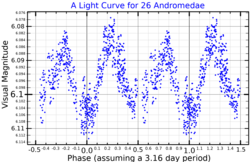Astronomy:26 Andromedae
26 Andromedae, abbreviated 26 And, is a binary star system[1] in the constellation Andromeda. 26 Andromedae is the Flamsteed designation. It has a combined apparent visual magnitude of 6.10, which is near the lower limit of visibility to the naked eye. The distance to this system can be estimated from its annual parallax shift of 5.35 mas, which yields a distance of about 600 light years. At that distance, the visual magnitude of the stars is diminished from an extinction of 0.04 due to interstellar dust.[3] The system is moving further from the Earth with a heliocentric radial velocity of +3.3 km/s.[9]
The magnitude 6.11[3] primary, component A, is a B-type main-sequence star with a stellar classification of B8 V.[6] The star has 3.54[5] times the mass of the Sun and 3.76[12] times the Sun's radius. It is around 95[6] million years old and is spinning with a projected rotational velocity of 18 km/s.[5] 26 And is radiating 219[6] times the Sun's luminosity from its photosphere at an effective temperature of 11,939 K.[6] It displays an infrared excess that suggests a circumstellar debris disk orbiting at a distance of 169.3 astronomical unit|AU from the star with a temperature of 75 K.[12]
The fainter secondary, component B, is a magnitude 9.70[3] star located 6.2″ from the primary. It is an F-type main-sequence star with a class of F3 V that shows an unexplained long term variability.
One of the components of this system displays a slight photometric variation with a period of 3.16 days. This may be caused by pulsation or an ellipsoidal variation.[1] This system's X-ray emission hasn't been detected yet, with an upper limit of Lx < 29.79 erg/s.[3]
References
- ↑ 1.0 1.1 1.2 1.3 1.4 Zasche, P.; Svoboda, P. (May 2008), "The Unconfirmed Eclipsing Nature of V348 And and Detection of Variability of HD 1438", Information Bulletin on Variable Stars 5827: 1, Bibcode: 2008IBVS.5827....1Z.
- ↑ 2.0 2.1 2.2 2.3 2.4 2.5 2.6 2.7 Vallenari, A. et al. (2022). "Gaia Data Release 3. Summary of the content and survey properties". Astronomy & Astrophysics. doi:10.1051/0004-6361/202243940 Gaia DR3 record for this source at VizieR.
- ↑ 3.0 3.1 3.2 3.3 3.4 3.5 Huélamo, N. et al. (July 2000), "X-ray emission from Lindroos binary systems", Astronomy and Astrophysics 359: 227–241, Bibcode: 2000A&A...359..227H.
- ↑ 4.0 4.1 4.2 4.3 4.4 4.5 4.6 4.7 4.8 Vallenari, A. et al. (2022). "Gaia Data Release 3. Summary of the content and survey properties". Astronomy & Astrophysics. doi:10.1051/0004-6361/202243940 Gaia DR3 record for this source at VizieR.
- ↑ 5.0 5.1 5.2 5.3 5.4 Zorec, J.; Royer, F. (2012), "Rotational velocities of A-type stars. IV. Evolution of rotational velocities", Astronomy & Astrophysics 537: A120, doi:10.1051/0004-6361/201117691, Bibcode: 2012A&A...537A.120Z.
- ↑ 6.0 6.1 6.2 6.3 6.4 6.5 6.6 6.7 Wyatt, M. C. et al. (July 2007), "Steady State Evolution of Debris Disks around A Stars", The Astrophysical Journal 663 (1): 365–382, doi:10.1086/518404, Bibcode: 2007ApJ...663..365W.
- ↑ Anderson, E.; Francis, Ch. (2012), "XHIP: An extended hipparcos compilation", Astronomy Letters 38 (5): 331, doi:10.1134/S1063773712050015, Bibcode: 2012AstL...38..331A.
- ↑ Samus, N. N. et al. (2009). "VizieR Online Data Catalog: General Catalogue of Variable Stars (Samus+ 2007-2013)". VizieR On-line Data Catalog: B/GCVS. Originally Published in: 2009yCat....102025S 1: B/gcvs. Bibcode: 2009yCat....102025S.
- ↑ 9.0 9.1 Steenbrugge, K. C. et al. (May 2003), "Radial velocities of early-type stars in the Perseus OB2 association", Astronomy and Astrophysics 402 (2): 587–605, doi:10.1051/0004-6361:20030277, Bibcode: 2003A&A...402..587S.
- ↑ Gontcharov, G. A. (November 2012), "Spatial distribution and kinematics of OB stars", Astronomy Letters 38 (11): 694–706, doi:10.1134/S1063773712110035, Bibcode: 2012AstL...38..694G.
- ↑ Lindroos, K. P. (May 1985), "A study of visual double stars with early type primaries. IV. Astrophysical data", Astronomy and Astrophysics 60: 183–221, Bibcode: 1985A&AS...60..183L.
- ↑ 12.0 12.1 12.2 Cotten, Tara H.; Song, Inseok (July 2016), "A Comprehensive Census of Nearby Infrared Excess Stars", The Astrophysical Journal Supplement Series 225 (1): 24, doi:10.3847/0067-0049/225/1/15, 15, Bibcode: 2016ApJS..225...15C.
- ↑ "26 And". SIMBAD. Centre de données astronomiques de Strasbourg. http://simbad.u-strasbg.fr/simbad/sim-basic?Ident=26+And.
External links
 |


